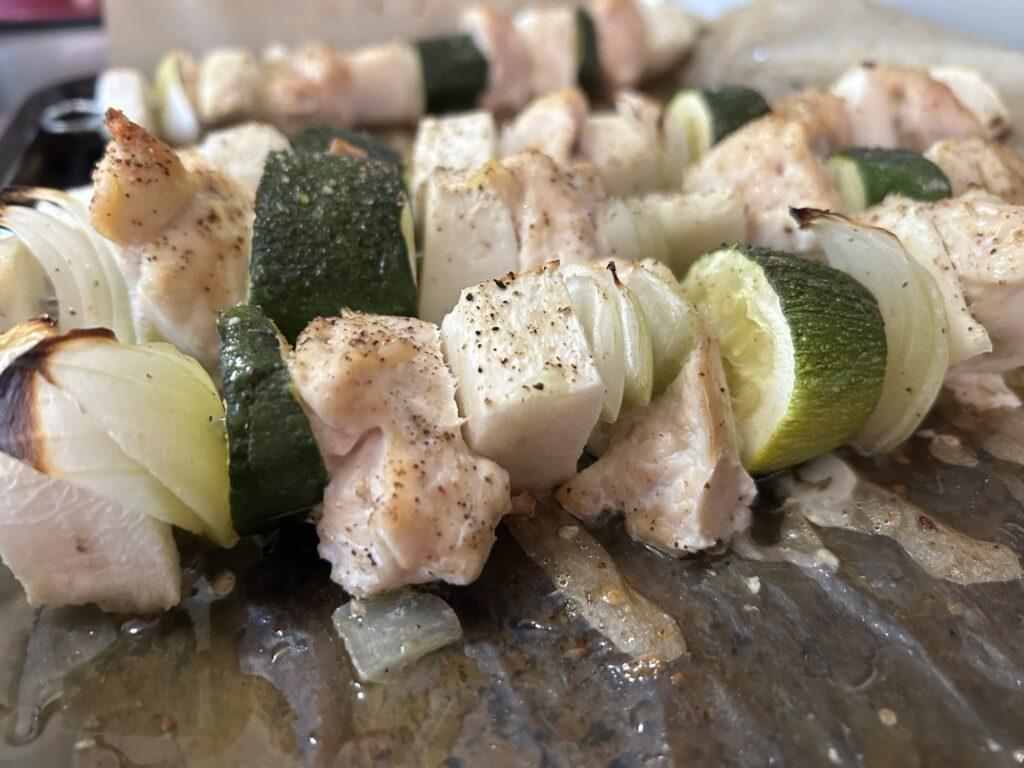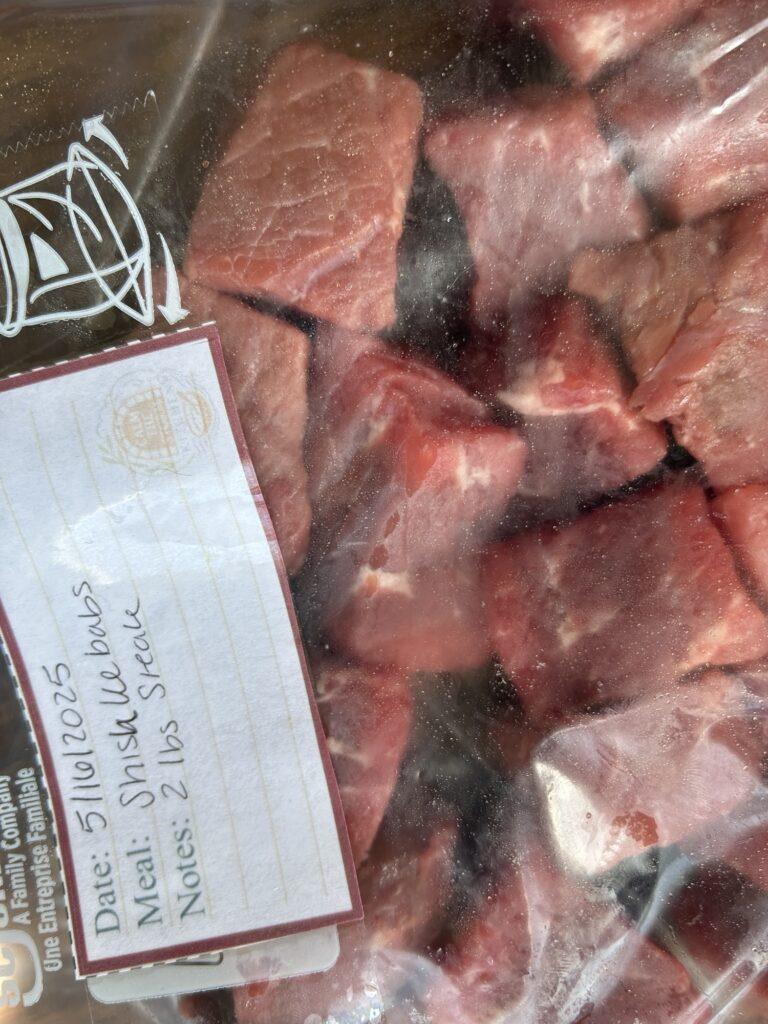A Survival Guide to Buying, Storing, and Safely Handling Meat for Histamine Intolerance
This post contains affiliate links. This means I may earn a small commission—at no extra cost to you—if you choose to make a purchase through one of these links. I only recommend products I personally use, trust, or believe could be helpful for you. Thank you for supporting my work and helping keep this blog running!
While histamine is naturally found in many foods, it also accumulates as a result of bacteria— particularly in protein-rich foods like meat. For those with histamine intolerance, consuming improperly handled meat can trigger symptoms—even when you are cooking something considered “safe”. Because histamine is not destroyed by cooking, prevention is all about proper storage and handling.
When it comes to histamine intolerance, time and temperature are everything. Histamine begins to form in meat as soon as bacteria start to break down amino acids—a process that accelerates if the meat isn’t kept cold. That’s why freshness is more than just a flavor issue for sensitive individuals; it’s a health concern. Avoid meats that have been aged, marinated, or heavily processed, and instead opt for fresh cuts that are stored and sold under strict temperature control.
Chicken and turkey are often the gentlest protein options for those navigating food sensitivities. If you’re dealing with sulfur-related symptoms, it’s best to avoid beef and lamb, as they tend to be higher in sulfur compounds that can aggravate symptoms. Pork, while a common staple, is a bit more controversial for those with histamine intolerance — it’s considered a potential histamine liberator, meaning it may trigger histamine release in the body even if it’s fresh. Some people tolerate it well, while others don’t, so it’s something you can cautiously test for yourself. That said, during strict elimination phases, it’s safest to leave pork off the plate.
Practically, how do I handle meat for histamine intolerance?
It starts with selecting meat. Getting meat from a local source that you can work with to ensure the shortest slaughter to frozen time is the best. If you can do that, great. To be real, we buy meat from the grocery store. Make sure the meat you’re buying has no dyes or additives— you’d be surprised if you have never read the labels carefully. Always check sell-by dates and avoid meat that has been sitting in open refrigeration for long periods. Higher surface area means more histamine production, so avoid pre-ground or overly processed meats. If you can chop or grind yourself then freeze, you will likely avoid a lot of histamine compared to buying it already prepared.
What to look for when selecting meat?
Color
- Beef: Should be bright cherry red on the surface (after being exposed to oxygen) and slightly purplish-red inside if vacuum-sealed. Brown or gray patches can indicate oxidation but also aging—avoid if unsure how long it’s been sitting.
- Lamb: Should be deep red with firm, cream-colored fat. Avoid if the flesh looks brownish, dull, or dry, or if the fat appears yellowed—these may be signs of aging or poor storage. Lamb naturally has a stronger smell than beef, but it should not smell sour or rancid.
- Fish: Look for clear eyes (if whole), shiny skin, and flesh that bounces back when touched. Dull skin, milky gills, or mushy flesh are red flags. You should avoid “fresh” fish unless you know it was recently caught (e.g., from a fisherman at a fish market). When we eat fish, we buy frozen fish—it seems to work for us.
- Poultry (chicken or turkey): Should be pinkish with white fat. Avoid if it looks yellowish, gray, greenish, or has dark, dried edges.
- Pork: Should be light pink with firm, white fat. Avoid if it turns dull, grayish, or develops dark spots. You should avoid pork as it is a histamine liberator, but I wanted to include for reference.
Smell
- Fresh meat should have a clean, mild smell. Any sour, ammonia-like, or “off” odors are a sign of spoilage and histamine buildup.
- A slightly metallic smell in red meat can be normal if it’s freshly vacuum-packed—but a strong or rotten odor is not.
Texture
- Fresh meat should be firm to the touch, slightly moist but not slimy or sticky.
- If the surface feels tacky, sticky, or leaves residue on your fingers, it’s likely starting to spoil.
Packaging Clues
- Look for tight, intact packaging with no puffing (which could indicate bacterial gas buildup).
- Vacuum-packed meat should be cool and have no excessive liquid in the packaging.
- Vacuum-packed meats are usually aged, so be sure to check that they’re not labeled as aged.
For histamine intolerance, it’s not just about spoilage—it’s about time and temperature. Even meat that looks and smells okay may still contain histamine if it’s been sitting too long above 4°C (40°F). When in doubt, choose frozen or freshly cut meat from a trusted source.
You’ve Picked Your Meat—Now What?
Once you’ve chosen your meat, the clock starts ticking—especially for those managing histamine intolerance. I always bring an insulated grocery bag (similar to this one) to keep my meat and cold goods chilled on the ride home. A simple step, but it makes a huge difference. Be sure to grab your perishable items last, check out efficiently, and head straight home without unnecessary stops.
When I get home, I immediately transfer any meat to the fridge, then start prepping it for freezing. First, I remove it from the original packaging—store-wrapped meat can trap moisture and promote bacterial growth. Next, I prepare the meat for the meals I’m planning that week: chopping, portioning, and seasoning as needed. I then place the portions in freezer-safe bags or containers, laid flat to freeze quickly and evenly.
After labeling everything with the date and contents, I store them flat in the freezer for easy stacking and fast thawing later. I repeat this process for all the meat I purchased that day—quick, simple, and effective at reducing the risk of histamine build-up.
It is seriously a life hack to prepare meat this way. Portioning and seasoning before freezing means that I can cook the meat from frozen. This reduces the amount of time where histamine production can occur. I usually do this by defrosting in cold water just enough to break the meat apart—freezing flat and not overfilling the container is the key to this— and then dumping onto my baking sheet or cast iron skillet to begin cooking. You may have to adjust cooking times depending on how frozen the meat is, how hot your oven really is, etc. I try to give a faithful estimate to the cook time, but you may find you need a little more time. This is where a meat thermometer is essential!
Handling Meat Safely
Safe meat handling is essential. I encourage you to read the WHO or USDA (or your preferred authority) guidelines for safe food handling.
Here is my adaptation, stricter for histamine intolerance:
- Always store raw meat at or below 4°C (40°F), and if you’re not cooking it within a day, freeze it immediately.
- When thawing, do so in cold water—not on the counter or in the fridge— or even better, cook from frozen (add about 50% cooking time) since room temperature speeds up bacterial growth.
- Use separate cutting boards for meat, wash your hands and utensils thoroughly
- Never refreeze meat that has been thawed.
- Cook meat thoroughly and use a thermometer to check.
To ensure safety when cooking meat—especially for those with histamine intolerance—it’s important to reach the right internal temperatures:
Poultry, including chicken and turkey whether whole or ground, should always be cooked to an internal temperature of 74°C (165°F). This ensures that harmful bacteria are destroyed.
Ground meats like beef, pork, and lamb should be cooked to at least 71°C (160°F), since grinding spreads any surface bacteria throughout the meat.
Whole cuts of beef, pork, lamb, and veal (like steaks or chops) are safe at 63°C (145°F), but it’s important to let them rest for at least three minutes after cooking, as the temperature continues to rise slightly and bacteria are killed during this time.
Pork is considered safe when cooked to 63°C (145°F) and allowed to rest—slightly pink in the middle is okay, as long as it hits the target temperature.
Fish and seafood should also be cooked to 63°C (145°F), or until the flesh becomes opaque and flakes easily with a fork.
When reheating leftovers, especially important for people with histamine sensitivity, make sure they’re heated all the way through to at least 74°C (165°F). This kills any bacteria that may have grown during storage, though it won’t remove histamine that’s already present.
Leftovers
We freeze our leftovers in airtight containers immediately. We like these containers because they are large enough to freeze the meal in a shallow layer, which makes defrosting easier. And, of course, remember to reheat to internal temperature of 74°C (165°F).
Meat Safety Reference Guide

I’ve created an easy-to-use Meat Handling Printable Digital Download Set to take the stress out of shopping, storing, and cooking meat—especially if you’re managing histamine intolerance or just want fresher meals and safer handling.
Here’s what you get (and how to use it):
- Freezer Labels
No more mystery bags! Label your meat with cut, date, and prep notes. Print on regular paper and tape them, or use 2×4″ adhesive label sheets like these ones for a cleaner look.
- Meat Freshness Cheat Sheet
Take the guesswork out of shopping. Use this reference to confidently choose the freshest cuts—perfect to fold and keep in your purse or glove box.
- Meat Handling Tips Sheet
A quick reference to the best practices to reduce histamine build-up. Keep this on the fridge for peace of mind when storing or prepping meat.
- Safe Cooking Temperature Chart
Hang this up in your kitchen for quick, no-fuss guidance to ensure every meal is fully and safely cooked.
Final Thoughts
Living with histamine intolerance can feel overwhelming at times, but with the right tools and habits, it’s absolutely manageable. Proper meat selection, safe handling, and smart freezing practices go a long way in reducing symptoms and supporting your overall health.
Thank you for reading this blog post! Meat handling is so important to get right. Not only for histamine intolerance, but also for preventing food borne illnesses. I pray that you and your family stay healthy and that this blog post serves you well.
The earth is the Lord's and all it holds, the world and those who dwell in it.
- Psalm 24:1 (NABRE)
Ready to put your new skills to the test? Try out my Shish Kebab Recipe!



Leave a Reply